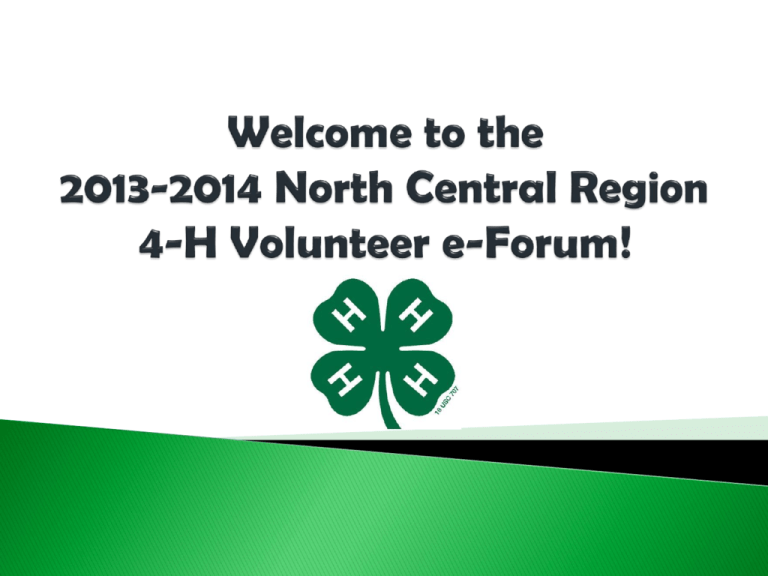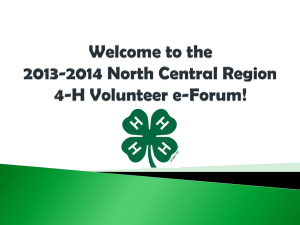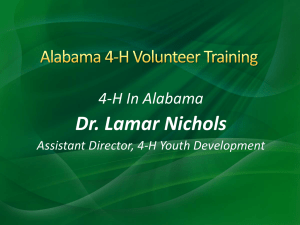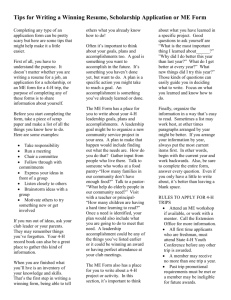2013 Engaging Teens & Youth PPT
advertisement

Session #2 Tuesday, December 3, 2013 Recipient of the National and North Central Region 2013 Salute to Excellence Volunteer of the Year Award 4 Recipient of the National and North Central Region 2013 Salute to Excellence Outstanding Lifetime Volunteer Award 5 Becky Harrington, University of Minnesota Kandi O’Neil, University of Wisconsin Brenda Shafer, University of Minnesota Rachelle Vettern, North Dakota State University 6 High quality youth programs Create engaging environment Strategies to engage youth What does the research say? ◦ Quality youth programs, those proven most effective and rated highly by young people themselves, make an intentional effort to engage youth at the highest level in planning, making choices, and reflecting on their learning (Zeldin, Larson, Camino, & O'Connor, 2005). ◦ Attention to making youth programs fun, interesting, welcoming, and encouraging to young people in our 4-H Youth Development programs is crucial to their continued vitality. 1) youth leadership development 2) sustained youth-adult partnerships 3) skill-building activities (Roth, & Brooks-Gunn, 2003) From grades 7 to 12, 4-H youth were significantly more likely than youth in other Out of School Time (OST) activities to contribute to their communities and to be active, engaged citizens. In Grade 11 (Wave 7), 4-H youth were 3.9 times more likely to actively contribute to their communities when compared with youth who are in other OST activities. (Lerner, 2013, February) What are you doing with the young people you work with to develop the Big 3? What are you doing with the young people you work with to develop ◦ Youth leadership ◦ Youth-Adult Partnership ◦ Skill-building Site Activity – 15 minutes Please take 10 minutes to complete this activity at your site Take a quick break Talk to you soon to hear your opinions! After completing the Opinion Line Activity Type into the chat box New roles you identified to engage teens and older youth in clubs and communities? What can adults do to support youth to engage in leadership roles? Program space free of health/safety hazards Healthy food/beverage choices First aid kit/ fire extinguisher visible Leaders show respect/inclusion of others Evidence of exclusion or bias among youth is addressed by program leaders Safe Environment Leaders encourage & support youth Involved/interacting with youth Ask open ended questions (How…?) Use encouraging, non evaluative language Support imperfect results & push to keep trying ◦ Know & appropriately challenge each youth ◦ ◦ ◦ ◦ supportive environment Youth partner with adults ◦ adults share control retain responsibility ◦ adults & youth talk Youth practice leadership skills ◦ Contribute to decisions and put forward ideas ◦ Take on new learning & leadership challenge Interaction Opportunities for voice and choice ◦ All Youth have chance to make content & process choices Opportunities to set goals & make plans ◦ Use of multiple planning and decision making strategies ◦ All youth encouraged to set project/program goals Engagement Youth Have Structured Opportunities to Reflect ◦ Intentional process of reflecting on what they are doing or what they have done ◦ Youth have structured opportunities to make presentation to the whole ◦ Leaders provide opportunities for youth to give feedback on program/activities Ladder of Learning & Leading 12 years 9 years 16 years Your 4-H Club has decided to offer a project day again for local elementary children. Consider the roles that both the youth and adults play in planning. Post-It® Planning Rotation Brainstorm Green Light, Yellow Light, Red Light Backwards Planning •Illinois •Indiana •Wisconsin •Minnesota •South Dakota •North Dakota •Michigan •Iowa •Missouri •Nebraska •Kansas •Ohio Specific Measurable Attainable Realistic Time-based 1. At the club meeting, the adult volunteer leader announced that the group would be picking up garbage at the local park as a service project. 2. At the club meeting, members in the club are given a choice between picking up garbage, raking leaves, or painting benches at the local park as a service project. After discussion on each option, the group decided to paint park benches, and an adult volunteer agreed to pick out the paint and supplies needed and all were told when and where to be to get the job done. 3. Youth were asked the question “what could we do to improve the park for our community service project”? The president led the group in discussion around the needs and opportunities for park improvement. After a number of ideas were generated and discussed amongst the members, they voted to build a bench and landscape around it with plants and flowers native to the region. They then broke into groups to discuss the design and construction of the bench and the landscape. Ongoing What? So what? Now what? Vary methods Plan Youth-led Postcards Ball Toss Talking Stick Chat with your Neighbor • Illinois • Indiana • Wisconsin • Minnesota • South Dakota • North Dakota • Michigan • Iowa • Missouri • Nebraska • Kansas • Ohio We welcome your feedback from tonight’s e-Forum session. Your responses will help us to better plan future programs for 4-H Volunteers. Site facilitators, please compile your site’s data and enter it into the survey link within 2 weeks of the session. 33 To access resources presented in the e-Forum sessions, please visit: http://www.uwex.edu/ces/4h/ncrvd/eForum2013.cfm A recording of this session is also available at this site and at: learn.extension.org 34 Hooray! You’ve Got 4-H Parents! Now What?? Engaging Teens/Older 4-H Youth (Tuesday, Using Technology to Enhance Your 4-H Experience Exploring the Science of 4-H Projects (Monday, (Monday, November 18, 2013) December 3, 2013) (Tuesday, January 14, 2014) February 3, 2014) All programs will be held from 8:00-9:30 p.m. (ET). Local activities begin at 7:30 p.m. (ET) 35 Lerner, J. (2013, February). Promoting a strength based vision of adolescence: The PYD perspective and findings from the 4-H study of positive youth development. Symposium conducted at the 2013 National 4-H Leadership Meeting, New Orlean’s, LA. Lerner, R. (2013, January). Positive youth development (PYD) and youth mentoring: Evidence from the 4-H study of PYD. Symposium conducted at the Meeting of National 4-H Council Mentoring Grant Conference, Chevy Chase, MD. Roth, J.L., & Brooks-Gunn, J. (2003). What is a youth development program? Identification and defining principles. In F. Jacobs, D. Wertlieb, and R.M. Lerner (Eds.) Enhancing the life of chances of youth and families: Public service systems and public policy perspectives. Vol. 2 of handbook of applied developmental science: Promoting positive child, adolescent, and family development through research, policies and programs (pp. 197-223). Thousand Oaks, CA: Sage. Zeldin, S., Larson, R., Camino, L., & O'Connor, C. (2005). Intergenerational relationships and partnerships in community programs: Purpose, practice, and directions for research. Journal of Community Psychology, 33(1), 1-10. Eccles, J. S. and J. A. Gootman (2002). Community programs to promote youth development. Washington, DC, National Acad-emies Press. Durlak, J. and R. Weissberg (2007). The Impact of After-School Programs that Promote Persona; and Social Skills. Chicago, I;, Collaborative for Academic, Social, and Emotional Learning. Akiva, T., & Jones, M. (2007) Youth PQA Handbook. Ypsilanti, MI: High/Scope Press Quality matters toolkit: Reflection. (2010). Minneapolis, MN: University of Minnesota Extension. Retrieved from http:/www1.extension.umn.edu/youth/staffonly/youthnu/youthnu_ handouts/11_handouts/qm-toolkit-reflection.pdf Quality matters toolkit: Voice and Engagement. (2010) Minneapolis, MN: University of Minnesota Extension. Retrieved from http:/www1.extension.umn.edu/youth/staffonly/youthnu/youthnu_ handouts/11_handouts/qm-toolkit-planning-structure.pdf Norb Yogerst, adult leader, Washington County, WI Luke Schowalter, youth leader, Washington County, WI Brianna Stapleton-Welch, Washington County 4-H Youth Development Educator, WI Lily Crume, youth leader, Clay County, MN








